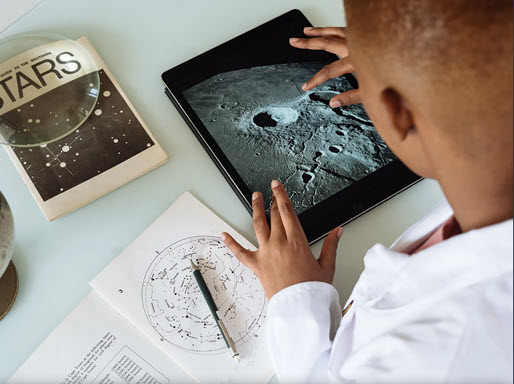Washington Depot, Connecticut, April 6, 2022 – Slooh, the only organization offering live online telescope feeds to students, is now making its award-winning learning platform and network of online telescopes accessible to families worldwide. Described by educators as “the complete package” that is truly “out of this world,” The Online Telescope for Families enables families to explore, capture, and analyze more than 1,000 real-world space objects and events using professional-grade technology together – all from the comfort of their homes.
“We want to make space exploration accessible to everyone, everywhere,” said Michael Paolucci, founder of Slooh. “For less than $10 a month, The Online Telescope for Families provides parents and children alike with an engaging – and fun – learning experience they can participate in together. Rather than having to buy expensive equipment that will end up collecting dust, families can now explore space just like real astronomers as they embark on starry expeditions, view and capture dynamic phenomenon, and ignite their love for space.”
Available for $9.95/month or $99/year, The Online Telescope for Families gives up to five family members control of a network of professional-grade online telescopes located in the Canary Islands and Chile. Families can book time on a telescope to view a specific space object or event or join other families in the Slooh community that have already reserved time to view and photograph astronomical phenomena.
During self-directed or guided exploration, families also have access to 50-plus Quests. These learning activities follow a learning progression, beginning with Starter Quests that enable novices to easily start exploring, and cover a range of topics from basic astronomy to the myths, history, and magic that can be found through the telescopes. Quests challenge families to use the telescopes to collect and analyze data to form their own conclusions while enabling them to explore space and learn important astronomical concepts.
“The Quests teach families about astronomy and the world around them in a truly accessible, unique, and innovative way,” said Paolucci. “Families can win badges as they complete the activities and even print out personalized posters featuring photographs they captured.”
The Online Telescope for Families also provides families with access to free star parties. During these interactive live streams, families are able to view newsworthy celestial events alongside a Slooh astronomer and expert guests.
To learn more about The Online Telescope for Families and to purchase an account, visit https://www.education.slooh.com/families.
About Slooh
Funded in part by a National Science Foundation grant, Slooh brings the wonders of space exploration to upper elementary through post-secondary students around the world. For almost 20 years, the company has provided the ability to view space phenomena, capture observational data, and engage in gamified learning through its patented user-controlled network of online telescopes in the Canary Islands and Chile. The company additionally provides robust professional development to help educators drive student learning. To learn more about Slooh, visit https://www.education.slooh.com/about.
- Educators Honored with YouScience® Innovative Educator Award - April 25, 2024
- CIESC Member Schools Gain Access to Metrasens Ultra Weapons Detection Systems Through New Partnership - April 24, 2024
- SchoolStatus Launches SchoolStatus Boost, an Innovative Educator Development Solution for Enhanced Teacher Growth and Development - April 22, 2024


